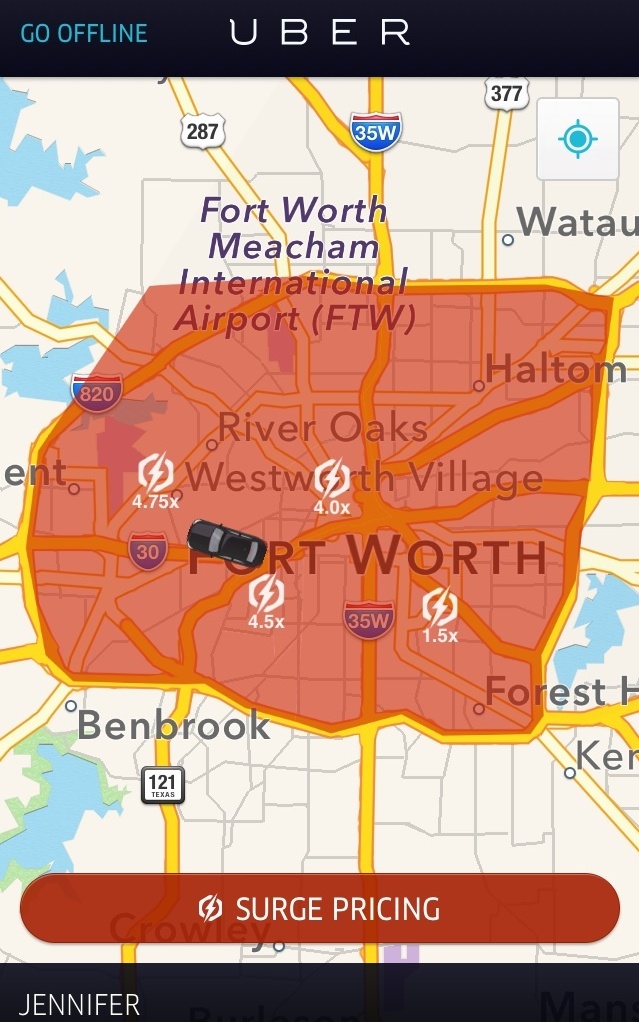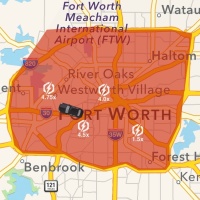New App – Clever Uber Workaround? Or Uber Fraud?

I read about a new Uber workaround app today called SurgeProtector on the Will Run for Miles blog. The idea behind the app is to help users deceive the Uber app during surge pricing by dropping the location pin (that requests a car) in a wrong location conveniently located outside the surge zone. Presumably riders would then contact their Uber driver and request that they pick them up in the correct location IN the surge zone.
The deception would creatively allow users to avoid the surge price while still utilizing a driver who would only be paid the standard fare price. I think this application is horrible and essentially a conduit to committing fraud.
Here is why I will be cancelling rides from passengers I suspect are using the app.
In Dallas/Fort Worth where I live (and drive), our zones are fairly large. The smaller zones are strategically drawn… in Fort Worth, for example, there is a zone for the university, a zone for downtown, and a zone for a popular entertainment district. As well there are geographically larger western and eastern zones.

I live at the apex of the western, university, and nightlife zones. Often when these zones surge, its due to specific events – closing time at the bars, the end of a college football game, a torrential downpour – and driving in these surges is often a wash because the time spent in traffic and corresponding gasoline burned is higher. I often look to surge pricing as “hazard pay”. Typically when it’s surging, it’s a higher risk time – whether the risk of being in a wreck in the middle of a downpour or the risk of a rider vomiting in my car due to it being 2:30 am.
Let’s take the case of a post-game reveler wanting a cheaper ride who uses SurgeProtector to request a ride during a surge (let’s call it a 3.0 multiplier just for even numbers). The app allows them to default to the nearest location away from the surge which in this case, would be an address about two minutes away from where I live (and normally originate my Uber rides from). I get the ride and drive to their location. In typical intoxicated rider fashion, it takes them two minutes to figure out how to call me – or better yet, they text with their correct location. By then, I’m already at the false location ready to start the ride.
But it turns out they are at the stadium which on a good day is ten minutes away – and probably twenty with traffic. I’m now driving that distance to pick up a ride where the rider is now angry that it has taken me that long to arrive – and possibly has cancelled the ride choosing instead to hail a cab or jump in a car with friends. Or worse, they have started walking and so when I arrive at the amended location, they are now four blocks away requiring another drive swimming upstream to reach them.
Then they jump in my car and go two miles in ten minutes, netting a fare of $5 – a fraction of the $15 they would have originally been charged. And of that $5, after I pay my $1 safe rides fee to Uber and their 20% cut, I’ve been left with $3.20. And the rider, in the meantime, is upset that there was a surge to begin with and angry that it took me 20 minutes to get there (since I was the closest driver to the fraudulent pin, not the closest driver to their actual location) so they rate me 1 star. My rating takes a hit which puts me at risk for deactivation.
Meanwhile, my fellow drivers who are sitting next to the surge are getting no rides, punishment for being in the correct place at the correct time.
Further, this app if widely used runs the risk of creating false surges. Surge pricing is based on the number of users in a location with the Uber app open versus the number of drivers available. If the rider number is higher than the driver availability, a surge will occur. Experienced rivers who have access to the zone maps and surge locations will frequently notice that as one surge disappears, an adjacent surge will often pop up as drivers float from one zone to the next as they try to chase the surge. Artificial surges will do nothing but push the geography further from the user’s actual location and will place the driver further away.
So no, I will not be using this technology. And when I’m driving, I will have no problem cancelling rides for users who do.
Is use of an app like Surge Protector committing fraud?
- Yes (78%, 38 Votes)
- It's an ethical grey area (12%, 6 Votes)
- No (10%, 5 Votes)
Total Voters: 52
So, how do you as a driver figure out in a timely manner that someone is suspect of using the app BEFORE you head into the first (non-surge) area? There is always someone coming up with a way to get around ‘the rules’ it seems.
We don’t – and that’s part if the problem. I really think Uber needs to require riders to have their location services switched on – and then charge them if they are not in their location.
On my android smartphone i have the Fake GPS app which can do more or less the same. Fake my GPS location and that even if location services has been turned on. I only use it for fun and giggles and would never use it to circumvent something like this. Ideally if the surgepricing was too high I would just opt for a walk home.
I just avoid @Uber @Uber_NYC when there’s surge pricing. Plenty of cabs in Manhattan. 2 drops of rain here = 2.0X surge.
Avoiding it is a better tactic than seeking to defraud drivers!
Uber needs to really crack down on crap like this. I think it would be a wonderful idea for Uber to require riders to have their location services turned on in order to request a ride.
Word I heard yesterday is that drivers should report rider who do this – and that if its a pattern, they will suspend the accounts of violating riders. Sounds fair to me!
wait – are you just looking at this from the perspective of a driver who wants to earn top dollar, rather than from the perspective of the passenger?
How is this fraud? There is no manipulation of location or charges. If Uber charges a multitude of prices in one vicinity, why can’t a passenger learn what his/her pricing options are before s/he books a vehicle. If it means walking across the street or around the corner to get a lower rate, what is wrong with that? Isn’t that what a consumer is entitled to know? Doesn’t Uber present itself as a more transparent and user-friendly option than traditional taxis and car services – and therefore, wouldn’t knowing the pricing in the vicinity be helpful so the passenger can make an informed decision whether to use Uber’s services or some other transportation option instead?
what am I missing here, other than the fact that the driver doesn’t receive the inflated surge fee?
I think you may not fully understand how this app works. There IS manipulation of location which is exactly what makes using this fraud. Let’s use two addresses to make my point. You are standing at 100 Main Street which is in the middle of the surge. By using Surge Protector, the pin now drops at 200 Grove Street which is three miles away but the closest location outside the surge zone. Surge Protector requests the ride from 200 Grove Street and pings the driver closest to that location and tells him to pick you up. But you are at 100 Main Street so now need to manually contact your driver and ask him to pick you up three miles away. You have successfully avoided the surge (assuming the driver doesn’t cancel your false request) but he/she now has to drive three miles while not being compensated for the time/mileage to do so because he can’t start the fare until you are in the car. The use of a false address is fraud. And Uber has every right to cancel the accounts of those committing it.
here’s an excerpt from Lifehacker.
“SurgeProtector is a simple app, but it’s not perfect yet. Currently, it only searches for areas within a kilometer for you. Nonetheless, in cities with denser populations like San Francisco, you could walk just two or three blocks and find an area unaffected by surge pricing. SurgeProtector may not be as useful in suburban areas.”
To the extent the app simply finds locations close by and thus gives you the option to go to those other locations for pick up – I disagree with you. To the extent however, that the app could somehow manipulate the GPS and deceive the Uber pricing mechanism to believe that you are somewhere entirely different than where you are – I agree with you.
I agree with walking to a non-surge zone to avoid the surge. That’s completely legit. As long as the rider is located where they drop the pin when the driver shows up, no issue.
The description you posted yesterday showed the app moving the pin for the request out of the zone and requesting the ride there and didn’t discuss mileage restrictions. Believe me, this is a hot button issue where I live (DFW) where riders doing the manual request moves is a real problem. One trend here is to get around the restriction on UberX airport pickups by dropping the pin outside the airport and then asking the driver to pick up inside the airport. We have been instructed to cancel those as the airport and taxi companies have been conducting sting operations to catch drivers circumventing rules. For the same reason, we aren’t supposed to do pickups away from where they were requested because it violates the (tenuous) rules Uber is already operating under.
I think it’s important when recommending hacks to folks that we also look at the ethics of what we are suggesting people do. Walking to a non surge pin drop in NYC is very different than requesting a pickup somewhere other than where a pin is dropped.
this is great. will try it next week.
You can do this same trick at the airport if Uber doesn’t pick up. Just move the pin outside the range and then once you have a driver, tell them you are at the airport.
This is definitely a risky proposition for drivers as many airports have been running sting operations to catch drivers picking up illegally. I was browsing DFW’s statutes and unauthorized car-for-hire pickups are stated to be a criminal offense. I know drivers who have been fined considerably (in one city, the fine is $1,000) so I personally refuse any of the “moved pin” pickups at the airport – too risky!
Can you just ask the rider to “re-Uber” at their current location once you are at their actual location?
You can – but there is no guarantee that if they “re-Uber” that they would get you. So then at that point you have passengers whose ride you have cancelled potentially sitting in your backseat and now paired withb a different driver – and you’ve wasted your time/gas driving there. It’s easier just to tell them to cancel and rerequest with the correct address.